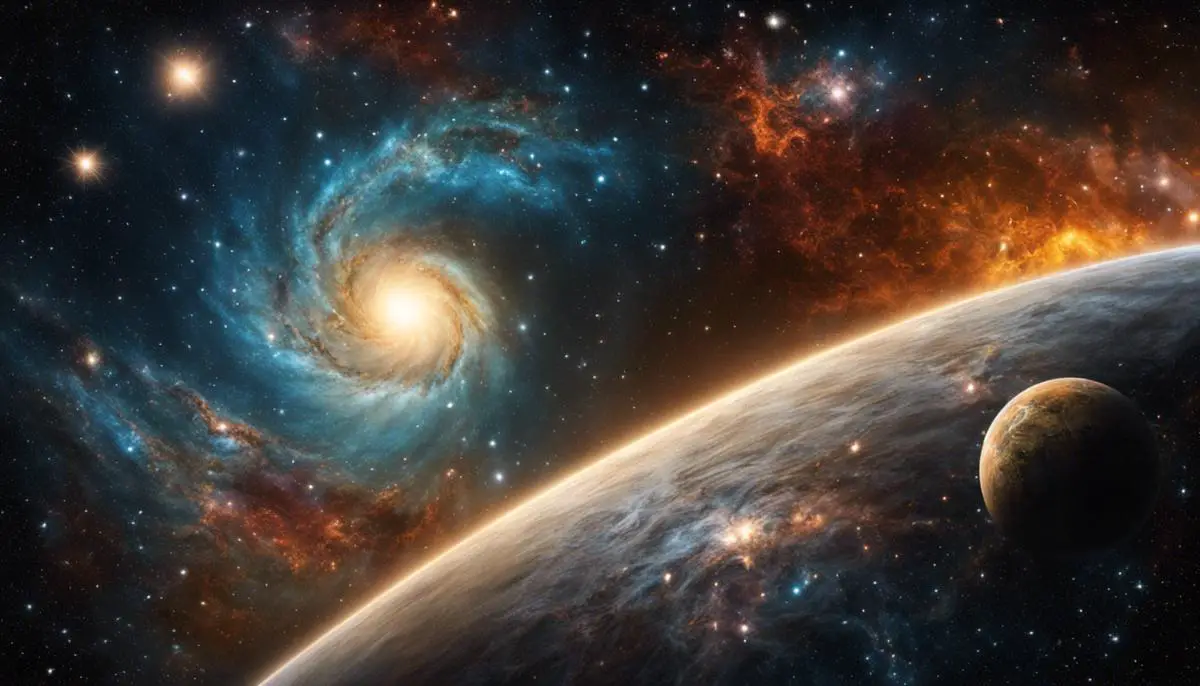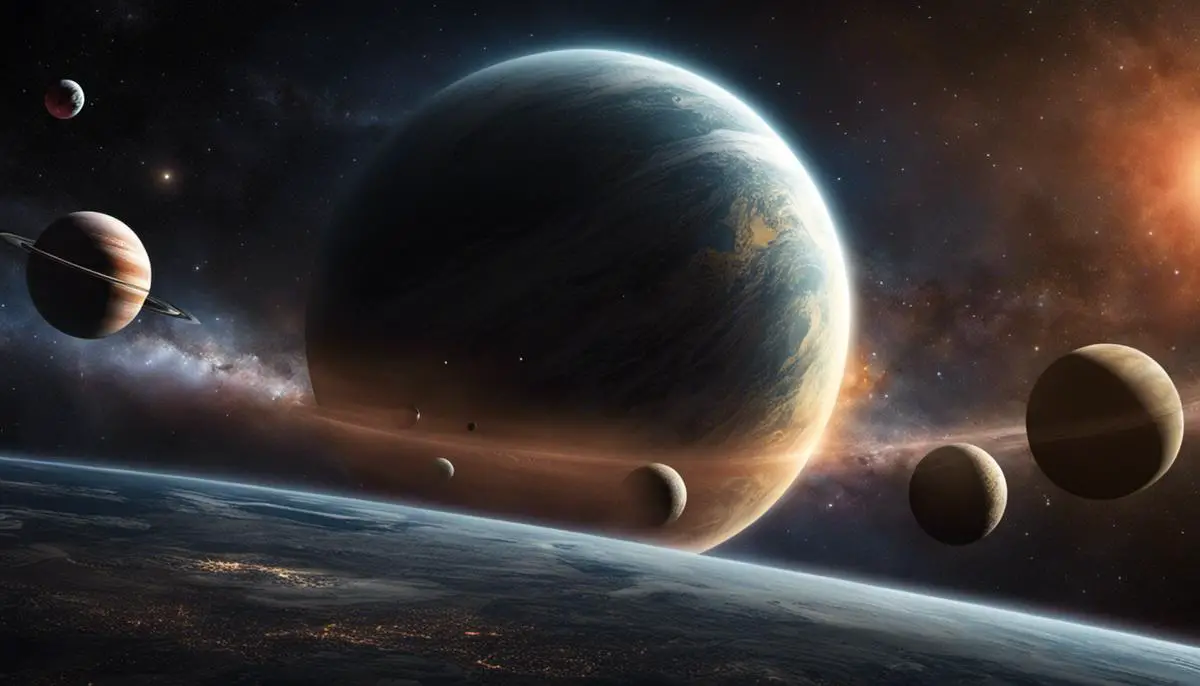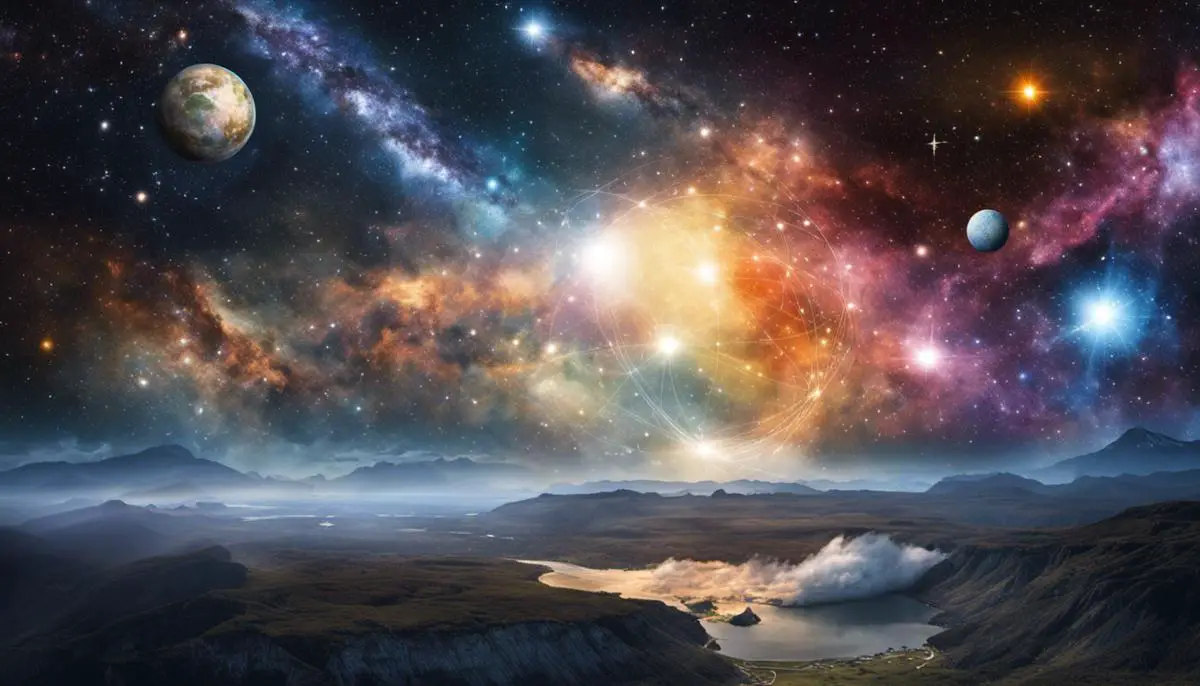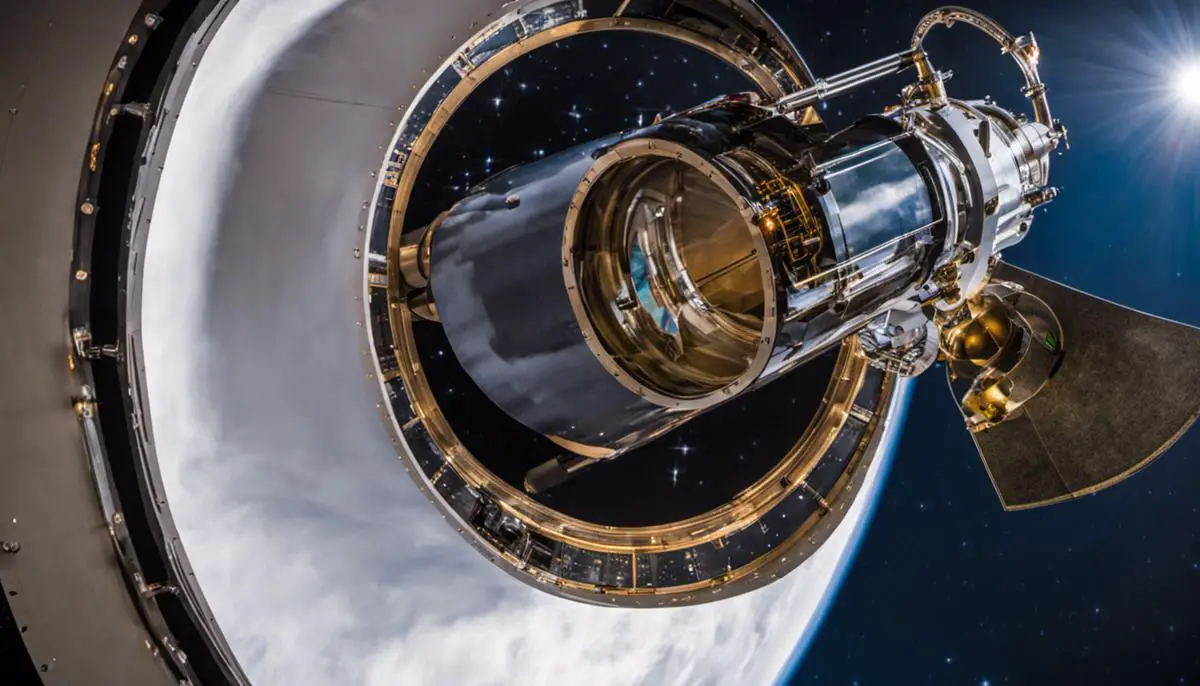Embracing a journey among the stars, our odyssey into the infinite realm of the cosmos begins here. As we prepare to traverse the immense expanses of space and time, let’s first ground ourselves with the foundational aspects of our vast universe. In the blink of an eye, we’ll transport from the macroscopic structure of the cosmos and the celestial entities that inhabit it to the most fundamental theories of science that elucidate its intricate mechanisms. As we seek to comprehend the evolving nature of the universe beyond our terrestrial sphere, we will also embark on the odyssey of space exploration made possible by human endeavor, delving into their monumental strides and envisioned future. Coming full circle, our explorations will take us in search of an all-important connection – the prospect of life beyond our pale blue dot. Lay back, gaze above, and let’s navigate this cosmic voyage together.
Understanding the Universe
Understanding the Universe: Basic Nature and Origin Theories
One of the prevalent theories around the origin of the universe is the Big Bang Theory. This theory posits that the universe originated from an extremely dense and hot state around 13.8 billion years ago and continues to expand. The Big Bang Theory is considered the prevailing cosmological model, supported by a range of observations including the Cosmic Microwave Background Radiation and the abundance of light elements in the universe.
Another theory is the Steady State Theory, which contradicts the Big Bang Theory by arguing that the universe has no beginning or end in time. It posits that matter is continuously created to maintain a constant density of the universe. However, this theory has lost its footing due to the lack of empirical evidence.
The Size and Structure of the Universe
Determining the size of the universe poses significant challenges due to its continuous expansion. Our view of the universe is limited by the speed of light, meaning we can only see objects that are within 13.8 billion light-years, considering that the universe is about 13.8 billion years old. Therefore, the size of the observable universe is estimated to be around 93 billion light-years in diameter.
In terms of structure, the universe is composed of galaxies which are grouped into clusters and superclusters. These structures are interconnected by vast voids, creating a complex cosmic web.
The Cosmic Web and Galaxies
Galaxies are extensive systems of stars, gas, and dust bound together by gravitational force. Our solar system is located in the Milky Way galaxy, which is part of the Local Group, a cluster of galaxies.
The cosmic web describes the large-scale structure of the universe, consisting of galaxy clusters and superclusters connected by filaments of dark matter and galaxies, with vast voids in between. This structure was formed due to gravitational forces and dark matter.
Surveying the Observable and Unobservable Universe
Imagine all we can presently see through our Earth-based and space telescopes as the Observable Universe. This includes all matter whose emitted light has reached our view since the universe first began to expand. Meanwhile, what lies beyond this field of vision is known as the Unobservable Universe, home to a whole realm of matter sitting beyond our cosmological reach. While our present knowledge and technological capabilities have allowed us to delve into remarkable depths of the universe, vast regions still remain out of sight. Nevertheless, the rapid pace of modern advancement holds great promise for the future unveiling of these yet unexplored cosmic territories.

Cosmic Objects & Phenomena
Exploring Planets: Various Small Worlds within the Greater Whole
If we narrow our focus to smaller celestial entities, we come across planets, which are objects in orbit around stars or even remains of stars. There are primarily two types: the Earth-like Terrestrial Planets and the Gas Giants, Jovian Planets. In our very own solar system, Mercury, Venus, Earth, and Mars qualify as Terrestrial Planets, all harboring solid, rocky surfaces. On the other hand, the Jovian category is occupied by planets mainly composed of hydrogen and helium, namely Jupiter, Saturn, Uranus, and Neptune. It’s a diverse mix of worlds, adding depth to our understanding of the Cosmos.
Stars: Cosmic Energy Powerhouses
Stars are gigantic celestial bodies made primarily of hydrogen and helium that produce light and heat through nuclear fusion. Our Sun is the most familiar star, key to life on Earth because of the heat and light it produces. Stars go through lifecycles – they form, mature, and eventually die. The death of a star can result in several outcomes, depending on the original mass of the star, including white dwarfs, neutron stars, and black holes.
Asteroids and Comets: Leftovers of Solar System Formation
Asteroids and comets are remnants from the early solar system. Asteroids, rocky or metallic in nature, are found mainly in the Asteroid Belt between Mars and Jupiter. Comets, composed of rock, dust, and ices, usually reside in the distant regions of our solar system. When they venture close to the Sun, the heat vaporizes the ices, which leads to the formation of a glowing coma and tail, a spectacular cosmic spectacle.
Black Holes: Enigmatic Entities of the Universe
Black holes are regions of spacetime exhibiting such strong gravitational effects that nothing — not even light — can escape from inside them. They are formed from the remnants of massive stars after they explode as supernovae. Even though black holes are invisible (because no light can get out), scientists can identify them by their extremely high gravitational pull on nearby objects, or by detecting the X-rays emitted from the material spiraling into them.
Galaxies: Vast Cosmic Assemblies
Galaxies are vast cosmic assemblies of stars, gas, dust, dark matter, and possibly exotic particles. They come in various shapes and sizes, from dwarfs with just a few billion stars to giants with 100 trillion stars. Our Milky Way is a barred spiral galaxy with an estimated 100-400 billion stars.
Supernova: The spectacular death of a star
A supernova is the explosion of a star, the largest explosion that takes place in space. A star can go supernova in one of two ways: when a white dwarf, the leftover core of a star like our Sun, accumulates matter from a nearby star until it exceeds a certain mass limit, or when a massive star exhausts its nuclear fuel and collapses under its own gravity. Supernovae can briefly outshine an entire galaxy and radiate more energy than our Sun will in its entire lifetime.
Unraveling the Mysteries of Neutron Stars and Pulsars
Picture the remnants of massive stars that have gone supernova – these collapsed cores known as neutron stars are the tiniest and most dense celestial bodies that we know of today. They possess an astounding level of density, such that a piece of a neutron star the size of a sugar cube would have the same weight as a mountain. One type of these celestial marvels, called a pulsar, spins rapidly and has high levels of magnetism. Their magnetic poles emit electromagnetic radiation which can be detected from Earth only when these beams are directed our way, giving off the appearance of pulsation in light and radio waves.

Theories of Cosmos
Exploring the Universe through the Lens of the Theory of Relativity
When it comes to understanding the cosmos better, we turn to theoretical physics and, in particular, to Albert Einstein’s Theory of Relativity. This significant scientific contribution involves two parts. Firstly, Special Relativity postulates that for any observer moving at a steady speed, they would perceive the laws of physics to be identical, and that light speed in a vacuum remains unchanged regardless of how fast the observer themselves is moving. Secondly, General Relativity frames gravity not as a force between two entities, but as a curvature in the fabric of spacetime that regulates the trajectories of objects. It’s this part of the theory that gives us a framework to comprehend the orbits of planets and how light bends when it passes by the Sun from stars situated far away.
Quantum Mechanics and the Cosmos
Quantum Mechanics, another core theory, gives us a framework for understanding how the smallest particles in the universe behave. Unlike classical physics, which suggests that objects have definite positions and velocities, quantum mechanics allows for particles to be in multiple places at the same time – a concept known as superposition. This theory also introduces the concept of ‘quantum entanglement’, where pairs or groups of particles can become ‘entangled’, meaning the state of one particle is instantly connected to the state of another, regardless of the distance between them. Quantum mechanics has profound implications for our understanding of the cosmos, suggesting that at its most fundamental level, the universe is not deterministic but rather full of probabilities and uncertainties.
The Mystery of Dark Matter and Dark Energy
Two of the greatest unresolved mysteries in cosmology are dark matter and dark energy. Dark matter is a hypothetical form of matter that’s not visible through any electromagnetic spectrum, but its existence is inferred from its gravitational effects on visible matter, light, and the structure of the universe. Scientists believe that dark matter makes up about 27% of the universe, with the rest being normal matter (5%) and dark energy (68%). Dark energy, on the other hand, is a form of energy thought to exist in all of space, causing the universe’s expansion to accelerate. While we can’t observe dark matter and dark energy directly, their effects provide some clues about the nature and evolution of the cosmos.
Diving into the Theory of Multiverses
Imagine a reality where our universe is just one of many, an infinite maybe. That’s precisely what the multiverse theory poses for consideration. This ideology suggests the existence of multiple universes, each with varying laws of physics, different timelines, even dimensions of space and time that differ from what we know. While still not a universally accepted part of physical cosmology, the concept of the multiverse is an intriguing angle to explore, as it presents thought-provoking questions about the core nature of our reality and our position within the cosmos.

Space Exploration & Observations
Unfolding the Cosmos: The Power of Telescopes in Space Observation
Telescopes are the indisputable backbone of space observation. From Galileo’s groundbreaking refracting telescope to the game-changing technologies of the Hubble Space Telescope, these instruments have revolutionized how we perceive the universe. Since NASA’s 1990 launch of the Hubble telescope, we’ve been able to take clearer, more detailed images of distant nebulae, far-reaching cosmic phenomena, expansive galaxies, and planet formations, significantly augmenting our knowledge in astronomy.
Dotted around the globe, observatories like the Mauna Kea Observatory in Hawaii and Chile’s Very Large Telescope (VLT) utilize these marvels of engineering to study light emitted from far-off cosmic entities. Such studies allow scientists to extract important data relating to the age, composition, and behavior of stars and galaxies further enriching our understanding of the cosmos.
Space Exploration: Unmanned Missions & Space Probes
The advent of space probe technology facilitated deep space exploration, propelling us beyond the boundaries of our own solar system. The most notable of these include Voyager 1 and 2, launched by NASA in 1977, known for their exploratory feats of the outer planets and for currently venturing into interstellar space.
More recent exploratory missions, such as New Horizons’ flyby of Pluto in 2015, have expanded our understanding of previously unexplored worlds and cosmic frontiers. NASA’s Mars Rovers, such as the Perseverance Rover, continue to explore the Martian surface, providing invaluable geological and atmospheric data, and the possibility of microbial life on Mars.
Space Exploration: Manned Missions
Manned missions have been a key part of space exploration since Yuri Gagarin’s historic orbit around the earth in 1961. They offer direct human interaction and involvement in space science experiments, repairs, and observation. The Apollo moon landings, spanning from 1969 to 1972, marked significant achievements in human space exploration.
Today, the International Space Station (ISS) serves as a multi-national laboratory for astronauts around the world to conduct scientific research. Its continuous occupation since November 2000, representing international cooperation in space, is an achievement in itself.
What’s Next in Space Exploration?
Groundbreaking missions are being planned by space agencies worldwide in the coming years. Take, for example, NASA’s ambitious Artemis program: its goal is to have humans set foot on the Moon again by 2024 and then develop a sustainable human presence before this decade ends. On another planet, the ESA’s ExoMars mission, scheduled for a 2022 launch, has hopes of digging deeper into Mars’ surface, searching for evidence of life forms.
Separate from the public sector, SpaceX, a private entity, has slated its future projects like Starship to voyage to the moon and even mark the beginnings of Mars colonization. These missions could signify a new chapter in human space exploration, extending our reach into the cosmic unknown.
There’s immense potential for the future of space exploration. As we aim to decode the secrets of the cosmos, any progress made, milestone achieved, or discovery unearthed, brings us a step nearer towards comprehending our positioning in this grand expanse of the universe.

Environment & Life Beyond Earth
Considerations for Extraterrestrial Life
Life here on Earth thrives under specific conditions like the availability of water, oxygen-rich environment, and certain temperature range, among other things. Yet, life existing elsewhere in the cosmos might be operating under entirely different circumstances. Still, scientists predict a few basic requirements. This includes the existence of liquid water, the availability of an energy source for metabolism, and the presence of chemical compounds such as carbon, hydrogen, nitrogen, oxygen, phosphorus, and sulfur.
The Search for Extraterrestrial Life
The search for extraterrestrial life takes on two primary forms: the search for microbial life within our own solar system and the search for technologically advanced civilizations outside of our solar system. The former includes missions to Mars and the moons of Saturn and Jupiter, where scientists believe there may be environments suitable for the existence of microbial life. The latter includes research involving the search for extraterrestrial intelligence, or SETI, which examines signals from space for indications of intelligent life.
Colonizing Other Planets or Moons
The colonization of other planets or moons is a concept that lies at the intersection of science, technology, and imagination. For many years, Mars has been considered one of the most promising targets for potential colonization due to its proximity to Earth and its relatively hospitable conditions. However, many obstacles remain, including the planet’s colder temperature, thinner atmosphere, and lack of liquid water on the surface. More recently, there has been increased interest in the potential for human colonization of the moons of Jupiter and Saturn, which are thought to contain vast oceans of liquid water beneath their icy surfaces.
Current Research Involved
The search for life beyond Earth and the possibility of space colonization requires multidisciplinary research, ranging from astronomy and planetary science to biology and engineering. One significant research area includes astrobiology, the study of the origin, evolution, distribution, and future of life in the universe. This field aims to answer fundamental questions about the potential for life to exist beyond Earth.
Additionally, scientists and engineers are working on the development of technologies for long-duration human spaceflight and the establishment of permanent human settlements on other planets or moons. Key research areas include the development of life support systems, radiation protection, propulsion technologies, and in-situ resource utilization, which refers to the use of local resources at the site of a space mission for life support, propellant production, construction, and manufacturing.

Our journey through the cosmos has taken us across the breadth of the universe, from the smallest cosmic particles to the farthest galaxies. We’ve grappled with grand theories and pondered those celestial phenomena that decorate our night sky. Journeying alongside humanity, we have witnessed their relentless pursuit of knowledge and the audacious endeavors that bravely push the boundaries of our understanding. We’ve examined the delicate balance that fosters life, and speculated on the existence of our cosmic neighbors. The more we unearth about the universe, the more awe-inspiring it becomes, and the more questions it naturally spurs. The cosmos, in its silent majesty, invites us again and again to seek, explore, and marvel. Just as the starlight that reaches our humble planet, may this newfound knowledge illuminate the cosmos in your mind, igniting curiosity, wonder, and an ever-deepening appreciation for our spectacular universe.
![]()
